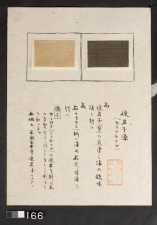Difference between revisions of "Karakuchinashi /Shikunshi - right (166 R)"
Jump to navigation
Jump to search
(username removed) |
(username removed) |
||
| Line 5: | Line 5: | ||
| 166 | | 166 | ||
|- | |- | ||
| − | ! scope="row"| | + | ! scope="row"|Uemura number / title |
| − | | | + | | ; "Haze-some 25" |
|- | |- | ||
! scope="row"|Folder location | ! scope="row"|Folder location | ||
| Line 41: | Line 41: | ||
| - | | - | ||
|- | |- | ||
| − | ! scope="row"| | + | ! scope="row"|Uemura's notes |
| − | | Karikuro (Myrobalans) is a nut collected from a tree, belonging to the Kuchinashi family. They are also known to be a source for tannin extract. According to a Chinese manuscript, the Honzo koumoku ( | + | | Karikuro (Myrobalans) is a nut collected from a tree, belonging to the Kuchinashi family. They are also known to be a source for tannin extract. According to a Chinese manuscript, the Honzo koumoku () from the 16th century AD, a Chinese manuscript titled Soh-Kaihouhonzou () from 10th century AD mentioned about this plant. |
|- | |- | ||
| − | ! scope="row"| | + | ! scope="row"|Uemura's date |
| Kyoto | | Kyoto | ||
|} | |} | ||
| − | [[Category: | + | [[Category:Uemura dye archive]] |
Latest revision as of 07:18, 24 July 2013
| Museum number | 166 |
|---|---|
| Uemura number / title | ; "Haze-some 25" |
| Folder location | 2nd shelf |
| Sample location | right (166 R) |
| Fiber type | silk |
| Color | black |
| Dyestuff (Japanese common name) | 使君子 : Karakuchinashi /Shikunshi |
| Dyestuff (botanical name) | Quisqualis indica L. |
| Plant part | fruit /dried (?) |
| Dyestuff extraction | boiled in water |
| Auxiliary agent in dye bath | - |
| Mordant | iron |
| Other auxiliary agent | - |
| Uemura's notes | Karikuro (Myrobalans) is a nut collected from a tree, belonging to the Kuchinashi family. They are also known to be a source for tannin extract. According to a Chinese manuscript, the Honzo koumoku () from the 16th century AD, a Chinese manuscript titled Soh-Kaihouhonzou () from 10th century AD mentioned about this plant. |
| Uemura's date | Kyoto |
